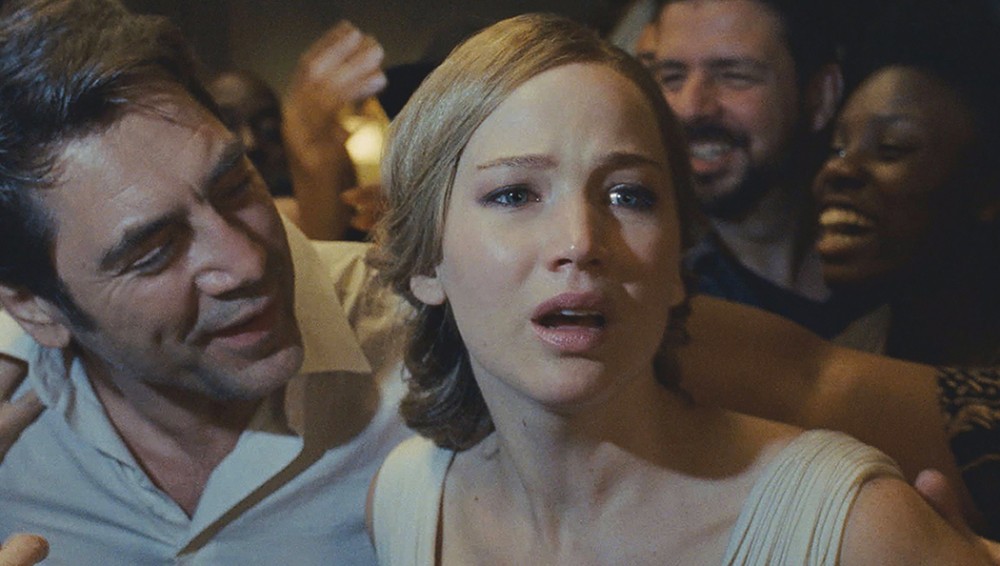The weight mother! bears
Darren Aronofsky's title character is the divine feminine, Mary, and Spirit; she's a little bit Gaia and a whole lot of the Feminine Principle.

Darren Aronofsky’s movies have explored the tortured creative life (Black Swan), surrealist psychological drama (Requiem for a Dream), and biblical allegory (Noah). He wraps all those elements into his latest film mother!
If you are a sucker for allegories like I am, you will be pulled into the pleasure of puzzling out biblical parallels. As you ask, “Wait, is that supposed to be . . . ?” (the answer is yes) and “I wonder how far he will take this?” (the answer is all the way), you will be grateful for your years of Bible study. It is hard not to like a movie that makes theological nerds feel cool. But the allegory has a deeply troubling view of creativity at its heart.
Read our latest issue or browse back issues.
The story starts out with a bang: an explosion hollows out a beautiful, rambling Victorian home. At the center of the home is a woman’s face, ringed in flames. In the debris after the fire, a man’s hands fit a beautiful crystal into a decorative case and we are in Ezekiel 37 territory: a rush of wind, a rattling noise, and ash and bone are restored to life. A woman gets out of bed and starts her day.
The woman, played by Jennifer Lawrence, is never called by a name, but is listed as “mother” in the credits. She is hard at work restoring the Victorian home. She spackles and paints, cooks and sews. Her husband (Javier Bardem) is simply listed as “Him.” Several decades older than she is, he is a famous poet working on his next big project. His writer’s block has put him in a sulky, distracted mood. He is delighted when a traveling doctor (Ed Harris) shows up at their door, mistaking the house for a bed and breakfast. Shocked by this intrusion, she becomes tight-lipped as she fulfills the role of hostess, shooting darts at her husband with her wide eyes. He deflects these with feigned ignorance, entranced by the energy of another person in the house.
Then the doctor’s wife (Michelle Pfeiffer) arrives, sloshing spiked lemonade on the refurbished floors and offering unsolicited sex advice in the laundry room. By the time their sons enter the picture, the biblical allegory is running full steam ahead, and we are only in the first few chapters of Genesis. The film then makes a mad dash to Revelation, with a detour through the Gospel of John.
Aronofsky has said that mother! is an ecological parable. This is why mother is a put-upon housewife, horrified when more and more guests destroy the home she has lovingly restored and maintained. But the ecological parable is muddled by a eucharistic allegory and a massive biblical arc. The mixed mythologies start to compete with each other.
Mother bears the weight of Christianity’s vexed ideas about femininity. She’s the divine feminine, Mary, and Spirit all rolled into one. She is also a little bit Gaia and a whole lot of the feminine principle as it roils its way through Western psychology from Freud to Jung to Lacan. In a sweeping freshman essay way, these ideas fit together. But the seams start tugging apart.
Perhaps Aronofsky is suggesting that, like Bardem’s Him, the Christian God is a fame hound, desperate for human adoration and too indulgent toward his fans. He’ll let hoards overrun the home so long as they keep asking for his autograph. The guests take his attitude as license to do whatever they will with the place. It could be a thesis worth exploring, but Aronofsky’s too distracted by his feminine principle to see it through.
The movie burns hot on its own manic energy but stops being fun right around the time mother suffers all the vile misogyny of the Western tradition. The problem is that Aronofsky is not just diagnosing what ails our overburdened home, he is prescribing a vision of creativity.
After the apocalyptic fires have burst forth and died down again and the wild field of creation is an ash heap, Him spells out the commitments at the heart of the whole adventure: he is a creator. It is what he does. And he can’t seem to create without sucking the life out of his feminine partner, whom he creates precisely so that she can give herself to Him in complete abnegation. He takes everything she has to give and then starts all over again on the ashes of her sacrifice.
The final scenes suggest that this endless taking and giving should be seen as beautiful and profound—a never-ending cycle of rebirth that keeps the male poet going. As the misogyny of this view of art and the creative life sunk in, I found myself muttering a word under my breath. It also starts with mother.
A version of this article appears in the November 8 print edition under the title “The weight mother! bears.”






